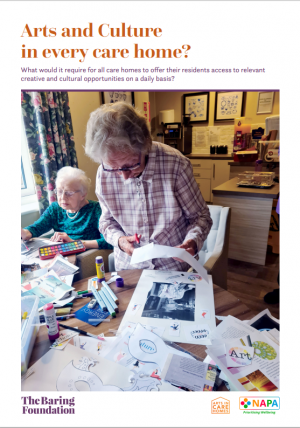In March 2021, NAPA was approached by The Baring Foundation about the feasibility of a daily relevant arts and cultural offer in all care settings. As an organisation whose main aim is to support meaningful activity and engagement, NAPA strongly believes that arts and culture have a crucial role to play in care provision. However, we wanted to find out if this view was shared by care providers and people living and working in care settings and to learn more about how such an offer might be achieved. NAPA led on a consultation with the care sector during the summer of 2021, the results of which are now available to read in this report.
The central question we posed was:
What would it require for all care homes to offer their residents access to relevant creative and cultural opportunities on a daily basis?
We wanted to find out how arts and cultural participation could be embedded into care provision. We were interested to see if a creative approach to care provision could allow for regular ongoing arts engagement throughout the day and be on offer every day in a meaningful person-centred way for every individual receiving care, as well as for the benefit of staff teams and relatives.
When asked if they felt a ‘daily offer’ was necessary and feasible, the majority of participating staff replied yes. In terms of what was needed to move towards this, staff responses varied according to their role, i.e. whether they were care staff, care managers, activity providers or care provider staff. The general consensus though was that they need:
- more resources
- more dedicated time for activities and engagement
- more creative ideas
- more community partnerships
- more access to digital devices and resources
- more training
- more teamwork
We also asked residents about their preferences, both in terms of active participation in arts activities and being part of an audience. What came across clearly from their responses is a strong belief in the beneficial outcomes of arts and cultural engagement and a desire to have access to more arts and creative opportunities. When asked what art activities they would like to do more of, the responses from residents included:
“I would like to get out to do painting from life and visit with artists.”
“I would like to continue to use my hands with woodwork.”
“I would like to do more colouring, stamp art, collages, origami, pastel,
different kinds of painting, woodwork, making boxes…”
“More paint canvases and brushes please.”
“I would like to write poetry in groups.”
“I am very keen to go to the theatre.”
All participating relatives told us that they would like see an arts and cultural offer in care settings. Many cited powerful examples of the benefits they had seen first-hand and the difference that the arts made in terms of happiness and quality of life. Nearly all of the relatives that responded also said they would like to be offered the chance to join in with arts and cultural activities in care settings with their loved ones.
As part of our study, we also shared a series of case studies highlighting relevant work currently being done by researchers, artists and arts organisations. Their suggestions for moving towards an embedded arts offer included:
- An artist in every care home
- The use of sensory props
- Specialist training for staff
- Promotion of awareness of health and wellbeing benefits of arts participation
- Consultation and involvement of residents in planning of arts activities
This consultation demonstrated clearly that partnerships between care settings and arts and cultural organisations are greatly valued by care settings and are seen by the care sector as an instrumental factor in terms of working towards a daily offer. The important role that the arts, culture and creativity have to play in terms of enhancing health and wellbeing has been highlighted during Covid-19. Going forward, we hope that artists, arts organisations, galleries, museums and archives continue to develop work with and for the care sector and that more funding for this valuable work is made available.
NAPA is a member organisation with more than 3,000 care setting members across the UK, with 25 years’ experience of working with the care sector. We have regular contact and communication with care settings, giving us a valuable insight into the needs of care providers, their staff teams, and the people they care for. This consultation has given residents, staff and relatives an opportunity to share their views, in the extremely challenging climate of the Covid-19 pandemic. We are very grateful to everyone who took the time to respond.
This survey was commissioned by the Baring Foundation as part of a national conversation in England about what it would take to embed a daily arts and culture offer in every care home. Read more about the project here.
NAPA Arts in Care Homes is a five-year programme funded by The Baring Foundation and Rayne Foundation. www.artsincarehomes.org.uk is a user-friendly website for anyone interested in arts in care settings. The National Day of Arts in Care Homes is an annual event which takes place on 24 September every year. Next year we hope to go International!
